With winter break upon us I couldn’t resist the prospect of vacating the village for a few days to discover some of the nature that the surrounding Transvaal had to offer; so with a few phone calls, clicks of the keypad, and a hastily packed duffel, I was off to neighboring Gautang province for a little getaway. Close as the place was, getting there was beyond just a trivial matter; without my own vehicle, I was faced with piecing together connections via the local taxi (shared van) services. So upon being let off at the Tau (lion in Setswana) gate of the Dinokeng Game Reserve, I was left fumbling around on my phone trying to secure a means of conveyance for the last, albeit short, leg of the trip. After a few unsuccessful attempts to summon a well known ride-share — and a couple SOS calls to the game lodge — I was finally on my way, arriving happily within 30 minutes of check-in (certainly, I was in no mood to waste a minute of this brief but needed vacation).
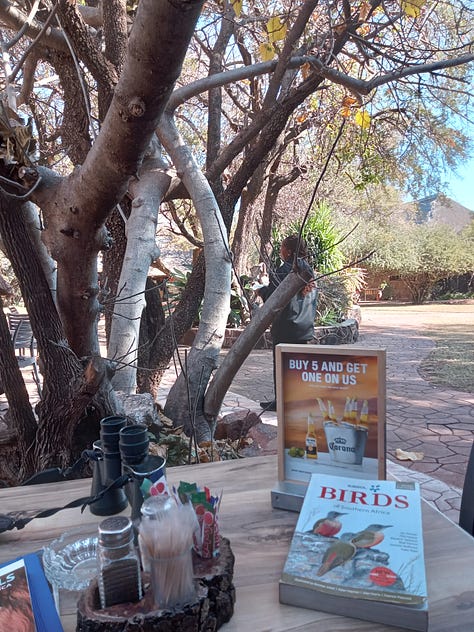
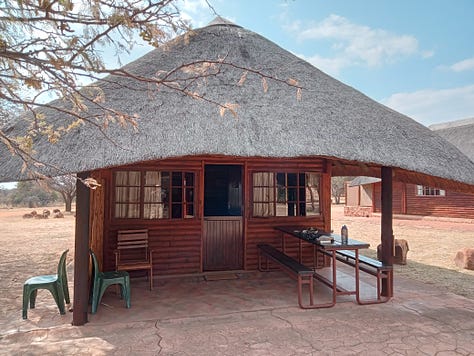
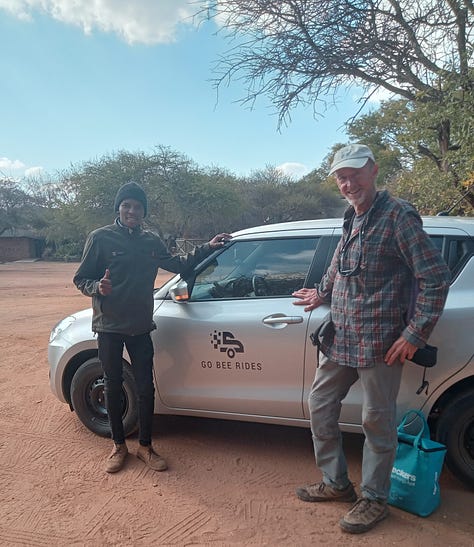
Kwalata Game Lodge, named for the sable antelope, offered all of the accoutrements that one could want — including comfortable accommodations, a cozy restaurant and guided excursions into the bush. And my capacious cabin — with its warm bed, kitchenette and indoor plumbing with hot water — was just what the doctor had ordered. In spite of its location just a few kilometers from a sprawling town, the property provided ample open vistas and tranquility — enough to fully relax and unwind. Indeed the long periods of quite were interrupted only occasionally by the squawks and chits of my only apparent neighbors: ground-scraper thrushes, southern red-billed hornbills and the stunning crimson-breasted shrikes. The Nile monitor however was more stealthy; I was only able to manage a glimpse of its massive tail as it disappeared into a nearby drainage culvert one morning.
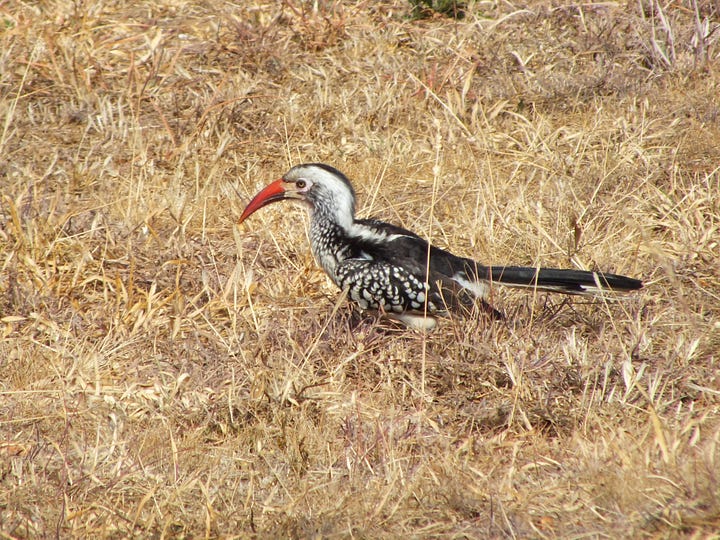

I soon learned that — in spite of my visit falling in the middle of winter break — the lodge was rather under-booked, which was fine with me aside from meaning that guided game drives would be in short supply. Nonetheless, I was able to hook up with some trips onto the preserve that did not disappoint. Our guide on the second one was Nati, a burly Afrikaner from Namibia who had been guiding (mostly hunters) on the veld for many years. His deputy Jacques took care of the driving and wielded the second rifle, just in case we were to run into any surly predators while venturing away from the vehicle. With the rules established — staying single file at all times; not talking; adhering to a photography protocol; and keeping our phones muted, “lest you end up skewered on the tusk of a startled elephant” — a French family and I piled into the customized wagon, with its theater seating, and set out on a chilly morning.
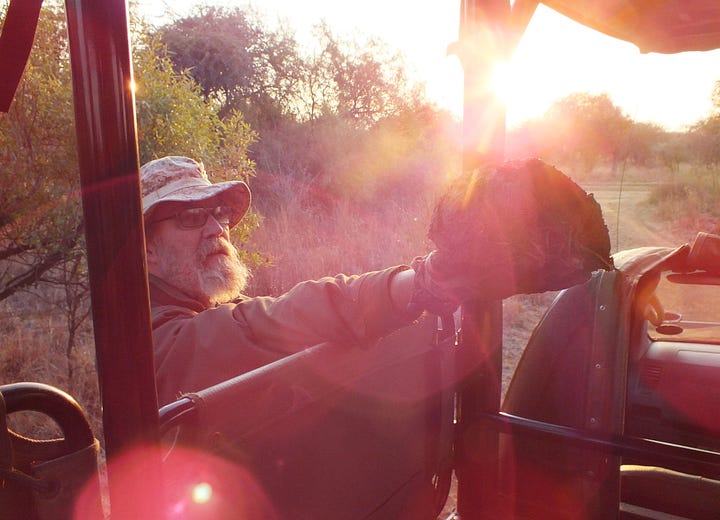
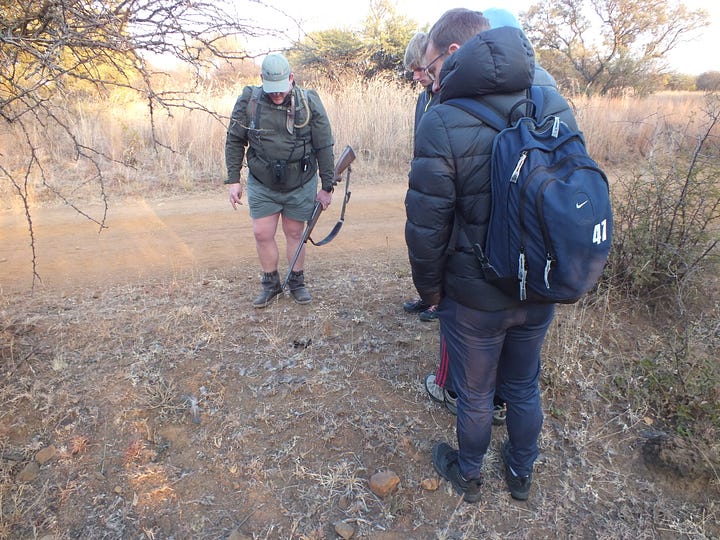
The sites and sightings were numerous and we were soon out of the vehicle on a fresh elephant track — there were also prints of hyena, jackal and various antelope species in the loose road dust. Listening for the thrashing of the elephants didn’t produce any sightings, however Nati did come back with a seven pound pile of partially desiccated elephant dung (that we were invited to handle) to be contrasted with the similarly appearing feces of the black rhino, a sample of which we would encounter later. Nati then led us into the bush on foot — checking back occasionally to ensure our compliance with his rules — to discover some the the less heralded denizens of the savanna.
Every plant had a story behind it: one was the guarri bush which — aside from yielding sweet edible berries that we got to sample — had woody twigs that could be frayed in such a way as to make an ideal brush for scouring teeth or applying paint. This was the tool that was believed to have been used to create the ancient cave paintings found scattered throughout southern Africa. Moving along, he next pointed out khakibos (khaki-bush), whose small drought-adapted leaves exuded a pleasant fragrance — or so I though; however Nati had other ideas: “We Afrikaners hate this plant. Can you guess why?” After a moment of awkward silence, glancing at Jacques for affirmation, he explained that the olive-colored bark that gave the plant its name bore a keen resemblance to the uniforms of the imperial British troops (who had menaced Nati’s forebears in two historic wars on this land); it was this association with all of its implications, perhaps more than the herb’s scent, that our guides could not abide.
One of our subsequent forays yielded the impressive skull of an unfortunate water-buck, a species that we learned actually had very little affinity for wet places. Then we wandered upon a small group of plains zebras, seeming to graze contentedly in the soft morning sun. In spite of their stature as one of the smaller zebra species, these handsome animals — with their alternating black and gray stripes — appeared quite formidable; when one started to exhibit a heightened curiosity in its two-legged visitors by edging in our direction, Nati moved in and deterred it with some tried-and-true bush bluster. Zebras, we were informed, need to be respected for the potential harm they can inflict just as much as the vaunted “Big Five” (African buffalo, rhinoceros, elephant, leopard and lion).
Next came tea break with Nati and Jacques dispensing cups of the sweet milky substance, along with dipping wafers, from the tailgate of the range rover. This interlude of civility, set amid a sea of thorn-bush and wild game, somehow conjured up scenes of British imperial scouts out on an erstwhile mission to chart the veld — think Livingstone or Churchill — everything there but the whiskey. The morning concluded with some driving along a meandering dirt road, which availed glimpses some of the bushveld’s marquee herbivores — giraffes, blue wildebeests, impalas, and a pair of grazing ostriches — while a couple of tuxedo-clad pied crows patrolled above. Evidently, these slightly comical looking birds are now the most reliable indicators of game kills in this area, which lacks the cliffs and large trees needed to support significant numbers their larger scavenging brethren: the vultures. And so, in returning to the lodge, our outing was drawn to a close as the day’s warmth was just beginning to reach the veld; it was not even 10:00 am. — the better part of a day, with all of its possibilities, lay ahead.








Happy Birthday, Drew. Big number this year. Enjoy the time off & take advantage of the African wildlife few of us will get a chance to see.
Thanks for sharing, Drew!! Love the stories and pics. Great to see one of you:)